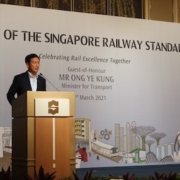IES Launches Singapore’s Inaugural Railway Standards
The Institution of Engineers, Singapore (IES) launched the nation’s inaugural railway standards yesterday, achieving a significant milestone in efforts to enhance the overall safety, reliability and productivity of Singapore’s railway services.
Under the national standardisation programme administered by Enterprise Singapore and supported by the Singapore Standards Council, a Technical Committee on Railway Systems (TCRS) was formed last year, to look into potential areas of standardisation. TCRS then identified four main areas—asset management, maintenance, safety and security, and service—and formed working groups to develop standards in these areas. These working groups consist of individuals from the regulatory authority, railway operators, industry stakeholders and academia. There are, in total, 17 working groups overseen by the TCRS.
Guest-of-Honour Mr Ong Ye Kung, Minister for Transport, launched the first three Technical References: terminology and abbreviations on the Permanent Way, maintenance regime of the Permanent Way (under the maintenance umbrella) and terminology for asset management of rail network assets (under the asset umbrella) today at the Shangri-La Hotel, attended by representatives from the Land Transport Authority and Singapore’s two railway operators, SMRT and SBS Transit.
Minister Ong said, “The standards are a collection of insights and experiences by the rail industry, crystallised to a set of common language. It is initiated by the industry, which makes this initiative even more valuable. It reflects the pride and cohesion of the professionals in this field.”
Ms Choy Sauw Kook, Director-General (Quality & Excellence), Enterprise Singapore, said, “Once completed, the Singapore Railway Standards will improve the railway system interoperability, product quality and service consistency. These standards will also help local enterprises understand the technical and safety benchmarks required to provide products and services in the operation and maintenance of the railway systems in Singapore and potentially in the region. I commend our standards partners for their pioneering work.”
The rail industry could benefit from standardisation in three ways:
- Enhancing consistency and interoperability through alignment, which would contribute to the building of a robust ecosystem to support and sustain the rail industry;
- Advancing competency amongst rail engineers and local businesses as they adopt the standards and align to best practices; and
- Continuous improvement as developers, designers and engineers work together to create and implement innovations and upgrades to enhance the rail network.
Dr. Richard Kwok, co-chair of Technical Committee on Railway Systems said, “We have come a long way since the TCRS was formed, and there are many other standards in the pipeline undergoing robust deliberations. The three inaugural standards launched today signal the collective effort by the industry to achieve greater railway safety and reliability.”
In the future, these railway standards could be good benchmarks for the regional and international rail industry, enabling Singapore to strengthen its leadership position in the global rail and transport sector. At the launch, Minister Ong also presented certificates of appreciation to the convenors of the working groups which completed the three standards. He also witnessed the launch of “The Learning Journey of the Singapore Railway Standards”, a commemorative book developed jointly by IES- Standards Development Organisation (IES-SDO) and SMRT to chronicle highlights in the journey to develop Singapore’s railway standards.
*Image courtesy of The Institution of Engineers, Singapore (IES)



